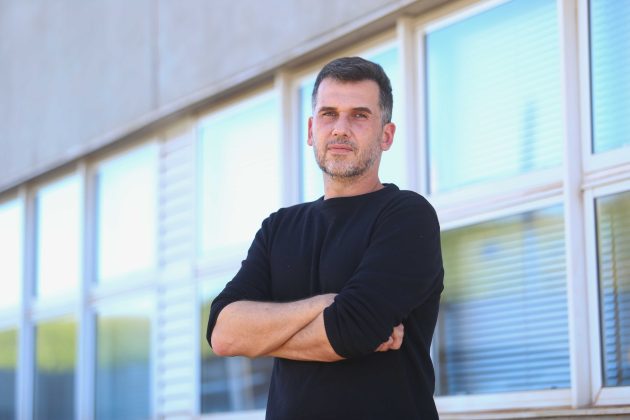 #Interviews
#Interviews
Technological diversity as a path to innovation at universities
Studies by UNICAMP researcher Bruno Brandão Fischer suggest that development policies should not only focus on trending technologies
 Bruno Brandão Fischer (UNICAMP) says that the discrepancy between cutting-edge research and economic activity in Brazil creates a barrier to technological advances in the country's productive sector | Image: Antonio Scarpinetti/UNICAMP
Bruno Brandão Fischer (UNICAMP) says that the discrepancy between cutting-edge research and economic activity in Brazil creates a barrier to technological advances in the country's productive sector | Image: Antonio Scarpinetti/UNICAMP
Academia is often heterogeneous, requiring a balanced approach to innovation and entrepreneurship that embraces the environment’s inherent plurality. These are the words of Bruno Brandão Fischer, a researcher at the Laboratory for Studies on the Organization of Research and Innovation (Lab-GEOPI) at the University of Campinas (UNICAMP).
Fischer is the author of various scientific articles on regional innovation systems and entrepreneurship ecosystems in universities. One of his most recent papers, published in the journal Research Policy, suggests that to promote inclusive economic growth, innovation policies should not be restricted to emerging technologies—meaning those that are in fashion at a given time—instead comprising broad groups, developing combinations of policies with varying objectives, requirements, and institutional arrangements.
In a study published in the journal Science and Public Policy, Fischer and colleagues analyzed the impacts that research-intensive universities have on local innovation ecosystems.
In São Paulo, they observed that public universities have a positive impact on their local innovation ecosystems.
They also identified that dedicated research funding and the existence of a support structure (incubators and science and technology parks) significantly enhance the benefits generated by research-intensive universities.
In an interview with Science Arena, Fischer, who has a PhD in economics and innovation management from the Complutense University of Madrid, Spain, talks about these two studies and other aspects of innovation and entrepreneurship in the university ecosystem, with an emphasis on the situation in Brazil.
Science Arena – Considering Brazil’s economic profile, which model for sustainable entrepreneurship and innovation in universities would be most beneficial to the country?
Bruno Brandão Fischer – It is difficult to name one single model for sustainable entrepreneurship innovation at Brazilian universities. Not only here, but in any country, teaching and research institutions are generally very heterogeneous, both between one another and internally; and they operate as part of ecosystems with highly distinct dynamics, profiles, and maturity levels.
Regarding the first point, it is common for people to make comparisons based on rankings that simplify the complexities of each institution’s capabilities and resources, as well as their organizational culture. Thus, the approach for promoting sustainable entrepreneurship and innovation must take this institutional context into account.
With respect to internal heterogeneity, this aspect is even less discussed, including in the scientific literature, even though it is something very intuitive for anyone immersed in the university environment.
There are different perspectives, orientations, and cultures at every institution, often demonstrating differences between colleges and institutes, but also frequently occurring within the institutions themselves due to the unique perspectives of different departments, research groups, and individuals.
What are the consequences of ignoring this heterogeneity?
Designing initiatives that ignore these issues tends to be counterproductive, resulting in a set of incentives that fails to take into account that innovation and entrepreneurship activities should not be mandatory for academic activities.
Of course, they are often desirable, but we should not create an environment in which a “traditional” academic finds themselves pressured to produce something that is not in their interest or professional scope.
We therefore need to take a balanced approach to innovation and entrepreneurship that embraces academia’s inherent plurality.
Hence the importance of understanding that universities are part of ecosystems with different dynamics, profiles, and levels of maturity?
We need to be clear that universities play an important role in sustainable economic and social development, but this is moderated by the characteristics of the innovation and entrepreneurship ecosystem that each university is part of.
The model adopted by a university located in a thriving industrial environment cannot simply be transposed to universities located in less economically developed regions.
The challenges and demands are different and each university’s contribution to regional development must be guided by this.
What are the main emerging technologies and the most traditional technologies in the university ecosystem? And what is the best way to diversify these technologies?
This is a very complex question, because the answer is linked to the research lines and capabilities of each university. What we have noticed in recent years is an obvious predominance in the development of artificial intelligence (AI). However, there are notable advances in chemistry, pharmaceuticals, and biotechnology, just to name a few cases that I know of at UNICAMP.
Logically, the buzz caused by emerging technologies facilitates access to financial resources, whether from private companies or funding agencies. This movement feeds certain market trends into the research environment and vice versa.
The best path here is not necessarily to diversify the research itself. This is something I believe we are already doing very well, at least at institutions here in São Paulo. The bigger challenge is to transfer these developments into the productive sector and thus encourage the diversification of technologies in the industry.
The discrepancy between cutting-edge research and economic activity in Brazil will logically find exceptions, but as a whole, it creates a barrier to technological advances in our productive sector.
Are there examples of policies adopted in Brazil or other countries to encourage technological development that have resulted in faster innovation and sustainable advances, driving local economic growth?
In Brazil, we have examples of initiatives that did not work—or at least, that did not achieve what they set out to do. This was the case, for example, with investments in national technological capabilities in the naval industry, or even investments in the automobile sector.
There were problems with the implementation, of course, but also problems with the understanding of priorities, in my opinion. Existing capabilities in Brazilian industry were not considered, which led to challenges that proved to be insurmountable—in the short term, at least. That is another problem. Very few of the initiatives were maintained for more than a short time. There is a lot of instability in the strategic guidelines.
The most recent success stories come from China, where they are following a very similar approach to that already taken in South Korea and even in Japan. These countries—perhaps partly due to the characteristics of their political systems and cultural traits—have a well-established, long-term vision of the process of creating internal capabilities.
China’s technological leap forward is the result of decades of learning from productive activities with low added value, through to the creation of industrial conglomerates with leading roles in high-tech industries.
We have seen this occur in microelectronics, electric vehicles, and more recently, in the aviation sector. There are lessons to be learned, but the model is based on very different contextual aspects to those observed in Brazil.
The main points that apply, however, are cumulative generation of capabilities from an existing base (the principle of relatedness) and long-term vision.
Based on patent data, your group identified the dynamics of technological knowledge in 96 countries, exploring growth rates and the technological importance of clusters in each of these nations. Are there any countries that stand out, either negatively or positively, and are there any parallels between their situations and Brazil’s?
It is difficult to highlight specific prominent positive or negative cases. I do not want to oversimplify the trajectories of these countries, which are not restricted exclusively to technological issues.
In my opinion, the key point here is understanding that technological diversification matters and is non-neutral. Different technological domains have different capabilities in terms of contributing to socioeconomic development, and this fact must not be ignored.
In recent times, Brazil has specialized in technologies far from the cutting edge—what we call outdated and established technologies. For middle-income countries, specializing in these types of technology signals a very limited future regarding income advancement. We need to become internationally competitive in the latest technologies.
We identified, for example, the fields of biotechnology and medical technologies as sectors in which we have broad scientific capabilities in universities that are not reflected in industry.
Your analysis looked at patents filed in these 96 countries over a period of four decades (1980 to 2021) and aimed to identify the factors behind why some countries went from low-income to middle- or high-income and others did not. What did you find out?
The main point is that technological activity is a central vector for economic development. There is no increase in income without industry being involved in the development of cutting-edge technology. And there is no shortcut to this.
You have to identify the frontier of the country’s technological knowledge, link this to its existing capabilities in the productive sector, and implement initiatives and incentives that promote areas with greater potential impact on socioeconomic development.
Public and private funding is limited, so prioritization is essential. And this prioritization is something that needs to be systematized. There is extensive literature on this, but it is often ignored in policy discussion and formulation.
What we end up seeing is a dispersion of funding that undermines the potential to generate any real impact. And then on top of that, we have programs that are not maintained for a long enough time.
Does having dedicated funds, incubators, and science and technology parks really enhance the impact of research carried out at universities? If so, how?
They have potential if they are well managed. How are these funds being allocated? Are they generating the critical mass necessary for the development of cutting-edge technological research and development? Such initiatives have been funded by the São Paulo State Research Foundation (FAPESP), but it is not happening across the rest of Brazil. In fact, in the state of São Paulo, we have possibilities that are closer to what is available in developed countries than to the dynamics seen in most developing nations.
This also applies to incubators and science and technology parks. I also worked on the development of a methodology for classifying and evaluating science and technology parks for Brazil’s Ministry of Science, Technology, and Innovation (MCTI), and it became quite clear to me that there is a lot of heterogeneity in the way these environments are managed.
Equally important is where these environments are located. They tend to function as catalysts for thriving ecosystems, but usually have more modest impacts in quieter locations.
They therefore need to be used as complementary strategies for broader policies and economic circumstances, not treated as silver bullets for structuring ecosystems—which is relatively common due to the political attention they generate.
The city of Florianópolis, in Santa Catarina, offers a very interesting example of this. Science and technology parks and incubators were created there to improve the retention of human capital and boost the local ecosystem, solving a specific problem and meeting a latent demand. Porto Digital in Recife, Pernambuco, is also a great example.
But there is a disparity between universities and companies in Brazil. This is particularly evident for intensive research and development (R&D) activities. Only 7.47% of innovative companies had formal relationships with universities in 2017. Of these, 58.4% were focused on R&D. These are small numbers.
On top of this, universities are not even seen by the business community as important partners for innovation. This is a situation that indicates weaknesses in the way the system is perceived.
*
This article may be republished online under the CC-BY-NC-ND Creative Commons license.
The text must not be edited and the author(s) and source (Science Arena) must be credited.


